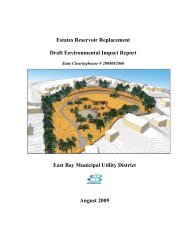Diet of Juvenile Fall-run Chinook Salmon in the Lower Mokelumne ...
Diet of Juvenile Fall-run Chinook Salmon in the Lower Mokelumne ...
Diet of Juvenile Fall-run Chinook Salmon in the Lower Mokelumne ...
Create successful ePaper yourself
Turn your PDF publications into a flip-book with our unique Google optimized e-Paper software.
112 CALIFORNIA FISH AND GAME DIET OF JUVENILE CHINOOK SALMON IN THE LOWER MOKELUMNE RIVER 1~and March <strong>of</strong> 1997 and most <strong>of</strong> 1998. Dramatic changes and fluctuations <strong>in</strong> streamvelocities affect benthic and drift organisms (Frankl<strong>in</strong> and Pearson 1968, Fisher andLaVoy 1972 Ward 1976, Petts 1984) and alter <strong>the</strong>ir availability to predators.Camanche D~m reached flood-stage release (142 m 3 /s) well before <strong>the</strong> majority <strong>of</strong>juvenile ch<strong>in</strong>ook emerged <strong>in</strong> 1997 (Fig. 2). Plankton tows i? Camanche R~servoiralong <strong>the</strong> dam face <strong>in</strong> spr<strong>in</strong>g 1996 showed dense populations <strong>of</strong> daphnllds andcyclopids <strong>in</strong> <strong>the</strong> water column (Merz 7 1997). These organisms may have beendispersed throughout <strong>the</strong> LMR dur<strong>in</strong>g high flow condit~ons <strong>in</strong> both 1997 an~ 1998.The relationship between zooplankton IRI values and rIver flow was strong In.bothyears, but statistically significant only <strong>in</strong> 1998. This suggest~ flow magm~ude<strong>in</strong>fluenced zooplankton consumption by juvenile ch<strong>in</strong>ook salmon In <strong>the</strong> LMR (~Ig. 2and 4). Thus, juvenile ch<strong>in</strong>ook salmon relied heavily on zooplankton early 10 <strong>the</strong>1997 season and began consum<strong>in</strong>g chironomids and larval suckers as <strong>the</strong> salmongrew and <strong>the</strong>se prey items <strong>in</strong>creased <strong>in</strong> availability la~er <strong>in</strong>.<strong>the</strong> s~ason.. Conversely,lower flows dur<strong>in</strong>g January <strong>of</strong> 1998 may have provIded JuvenIle chInook salmongreater opportunity to forage on chironomid larvae and pupae, Trichoptera and o<strong>the</strong>r·aquatic and terrestrial organisms (Fig. 2 and 4). .In summary, it appears that 3 factors affected juvenile ch<strong>in</strong>ook s~lmon feedInghabits <strong>in</strong> <strong>the</strong> LMR <strong>in</strong> 1997 and 1998. First, high flows probably Influenced <strong>the</strong>availability <strong>of</strong> prey, so that, at high flows, zooplankton (probably .from ~amanc~eReservoir) predom<strong>in</strong>ated <strong>the</strong> diet. As flows decreased, o<strong>the</strong>r prey Ite~s I~ <strong>the</strong> drIftbecame available and were more important <strong>in</strong> <strong>the</strong> diet. Second, prey SIze Increasedas <strong>the</strong> juvenile salmon grew. F<strong>in</strong>ally, feed<strong>in</strong>g rate, as <strong>in</strong>dicated by <strong>the</strong>.IF, <strong>in</strong>creasedas water temperature <strong>in</strong>creased. The importance <strong>of</strong>each <strong>of</strong><strong>the</strong>se factors IS confoundedby temporal trends and <strong>the</strong> fact that <strong>the</strong>y frequently co-vary. As ~oth 1?97 ~d 1.998were years <strong>of</strong>higher-than-normal precipitation an~flow, fut~re dle~ary I~vestl.gatlo~sshould be conducted dur<strong>in</strong>g more varied flow regImes and In conjunction WIth dnftand benthic sampl<strong>in</strong>g. This may better expla<strong>in</strong> <strong>the</strong> mechanisms <strong>in</strong>fluenc<strong>in</strong>g juvenilech<strong>in</strong>ook salmon feed<strong>in</strong>g behavior <strong>in</strong> <strong>the</strong> LMR.ACKNOWLEDGMENTSI thank S. Boyd, L. Chan, A. Choi, J. Jones, J. Setka, and M. Workman ~or t?eirassistance <strong>in</strong> field collections and <strong>the</strong> LMR field crew <strong>of</strong>Natural Resource SCIentIsts,Inc for <strong>the</strong>ir assistance. I thank J. Setka for his habitat assessment <strong>of</strong> <strong>the</strong> lower<strong>Mokelumne</strong> River. I also thank C. Hanson, D. Kohlhorst, E. Laca, J. Smith, and allwho provided <strong>in</strong>sight and review <strong>of</strong> this manuscript.7 Merz J.E. 1997. A survey <strong>of</strong> zooplankton along <strong>the</strong> face <strong>of</strong> Camanche Dam, Spr<strong>in</strong>g 1996.Mimeo Report, East Bay Municipal Utility District, Fisheries and Wildlife Division, Lodi,California, USA.LITERATURE CITEDBaldw<strong>in</strong>, C.M., D.A. Beauchamp, and J.1. Van Tassell. 2000. Bioenergetic assessment (temporal food supply and consumption demand by salmonids <strong>in</strong> <strong>the</strong> Strawberry Reservo:food web. Transactions <strong>of</strong> <strong>the</strong> American Fisheries Society 129:429-450.Berg, S. and J. Jorgensen. 1991. Stock<strong>in</strong>g experiments with O-plus and I-plus trout parSalmo trutta L., <strong>of</strong> wild and hatchery orig<strong>in</strong>: 1. Post-stock<strong>in</strong>g mortality and smolt yiel(Journal <strong>of</strong> Fish Biology 39:151-170.Bisson, P.A., J.L. Nielsen, R.A. Palmason, and L.E. Grove. 1981. A system <strong>of</strong> nam<strong>in</strong>habitat types <strong>in</strong> small streams, with examples <strong>of</strong> habitat utilization by salmonids dur<strong>in</strong>low stream flow. Pages 62-73 <strong>in</strong>: N.B. Armantrout, editor. Symposium on acquisitioand utilization <strong>of</strong> aquatic habitat <strong>in</strong>ventory <strong>in</strong>formation. American Fisheries Societ)Portland, Oregon, USA.Bowen, S.H. 1983. Quantitative description <strong>of</strong>diet. Pages 325-336 <strong>in</strong>: L. A. Nielsen and I:L. Johnson, editors. Fisheries Techniques. American Fisheries Society, Be<strong>the</strong>sdaMaryland, USA.Busby, M.S. and R.A. Barnhart. 1995. Potential food sources and feed<strong>in</strong>g ecology <strong>of</strong>juvenillfall ch<strong>in</strong>ook salmon <strong>in</strong> California s Mattole River lagoon. California Fish and Gam.81:133-146.Fisher, S.G. and A. LaVoy. 1972. Differences <strong>in</strong> littoral fauna due to fluctuat<strong>in</strong>g watelevels below a hydroelectric dam. Journal <strong>of</strong> <strong>the</strong> Fisheries Research Board <strong>of</strong> Canadi29:1472-1476. .Flecker, A.S. 1992. Fish trophic guilds and <strong>the</strong> structure <strong>of</strong>a tropical stream: weak direct vsstrong <strong>in</strong>direct effects. Ecology 73:927-940Frankl<strong>in</strong>, D. and W. Pearson. 1968. Some factors affect<strong>in</strong>g drift rates <strong>of</strong>Baetis and Simuliida(<strong>in</strong> a large river. Ecology 49:75-81.Hurtubia, J. 1973. Trophic diversity measurement <strong>in</strong> sympatric predatory species. Ecolog)54:870-890.Hyslop, E.J. 1980. Stomach contents analysis - a review <strong>of</strong> methods and <strong>the</strong>ir applicationJournal <strong>of</strong> Fish Biology 17:441-429.Johnson, J.·and E. Johnson. 1981. Feed<strong>in</strong>g periodicity and diet variation <strong>in</strong> diet compositior<strong>of</strong> subyearl<strong>in</strong>g coho salmon, Oncorynchus kisutch, and steelhead, Salmo gairdneri, <strong>in</strong> a.small stream dur<strong>in</strong>g summer. Fishery Bullet<strong>in</strong> 79:381-376.Johnson, J.H. and N.H. R<strong>in</strong>gler. 1980. <strong>Diet</strong>s <strong>of</strong>juvenile coho salmon (Oncorhynchus ldsutch)and steelhead trout (Salmo gairdneri) relative to prey availability. Canadian Journal 01Zoology 58:553-558.Maki-Petays, A., T. Vehanen, and T. Muotka. 2000. Microhabitat use by age-O brown troutand grayl<strong>in</strong>g: seasonal responses to streambed restoration under different flows.Transactions <strong>of</strong> <strong>the</strong> American Fisheries Society 129:771-781.Merz, J.E. and C.D. Vanicek. 1996. Comparative feed<strong>in</strong>g habits <strong>of</strong>juvenile ch<strong>in</strong>ook salmon,steelhead, and Sacramento squawfiish <strong>in</strong> <strong>the</strong> lower American River, California. CaliforniaFish and Game 82:149-159.Moyle, P.B. 1976. Inland fishes <strong>of</strong> California. University <strong>of</strong> California Press, Berkeley,California, USA.Mundie, J.H. and D.G. Crabtree. 1997. Effects on sediments and biota <strong>of</strong>clean<strong>in</strong>g a salmonidspawn<strong>in</strong>g channel. Fisheries Management and Ecology 4:111-126.Petts, G.E. 1984. Impounded rjvers. John Wiley & Sons, New York, New York, USA.

















